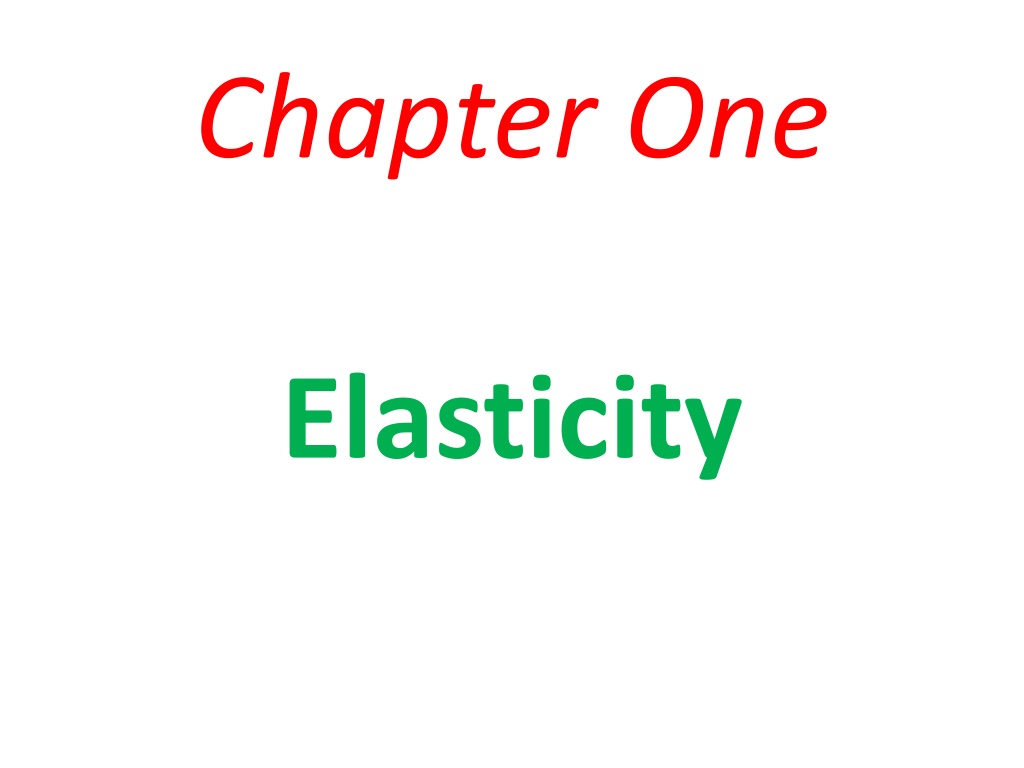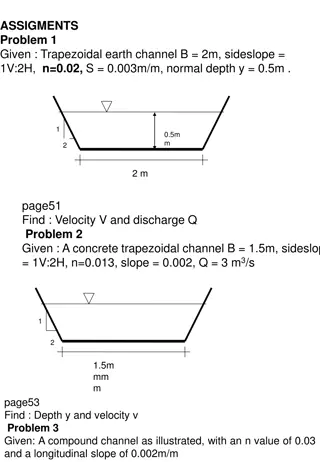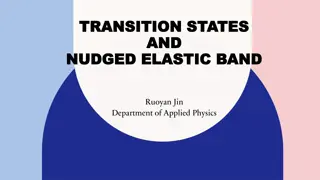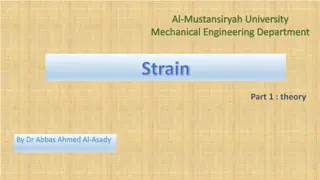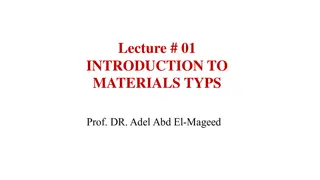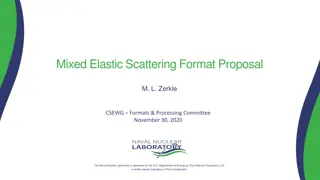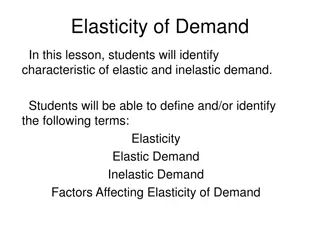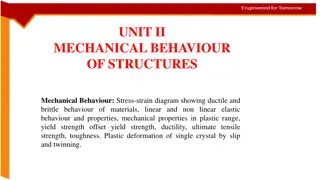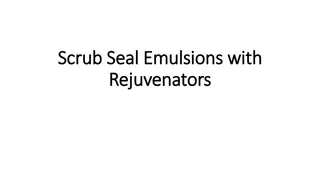Understanding Elastic Properties of Materials
Stress and strain are key concepts in understanding the elasticity of materials. Stress is the force acting on an object per unit area, while strain measures the degree of deformation due to stress. Different types of stress include tension, compression, and shear stress. The relationship between stress and strain can be studied experimentally to determine material properties.
Download Presentation

Please find below an Image/Link to download the presentation.
The content on the website is provided AS IS for your information and personal use only. It may not be sold, licensed, or shared on other websites without obtaining consent from the author. Download presentation by click this link. If you encounter any issues during the download, it is possible that the publisher has removed the file from their server.
E N D
Presentation Transcript
Chapter One Elasticity
Elastic Properties of Materials -Stress - Strain - Young s Modulus Chapter One 2
Stress and Strain Stress is a quantity that is proportional to the force causing a deformation. Stress is the external Force acting on an object per unit cross-sectional Area. Strain is the result of stress ,which is the measure of the degree of deformation . Chapter One 3
Types of stress Tension Stress Compression Stress Shear Stress Chapter One 4
Types of Stress Tension of Stress : is the force per unit area producing elongation of an object. F F Tension Chapter One 5
Compression of Stress : is the force per unit area producing compression of an object. F F Compression Chapter One 6
Shear of Stress : is the opposite sliding force applied to parallel force of the object . Producing change in shape of material without changing its volume F F Shear Chapter One 7
Stress Stress : Force per unit area = ? ? F:Force applied in Newton A:cross sectional area in m2 : Stress in N/m2 A F Chapter One 8
Strain :Ratio of elongation of material to the original length = ? length of a material (m) and is strain ,Dimensionless. ??, where : l : elongation(m),lo : original Elongation l =lf lo Where : lf loaded length of a material(m) lo lf Chapter One 9
Relation between Stress and Strain The relation between the stress and the strain for a material under tension can be found experimentally . A plot of stress vs. strain . The diagram gives us the behavior of the material and material properties Chapter One 10
Chapter One 11
Elastic Limit For small values of the strain , the stress strain graph is a straight line ; the stress is linearly proportional to the strain .Beyond the linear limit A ,the stress is no longer linearly proportional to the strain .However ,from A to the elastic limit or yield point B ,the object still returns to its original dimensions when the applied force F is removed . Chapter One 12
The deformation up to B is said to be elastic If the applied force is further increased ,the strain increased rapidly . In this region ,if the applied force is removed ,the object does not return completely to its original dimensions; it retains a permanent deformation .The highest point C on the stress-strain graph is the ultimate tension strength 1 of the material or its maximum stress .Beyond this point ,additional strain is produced even by a reduced applied force , and fracture occurs at point D .From B to D the material is said to undergo plastic deformation .If the ultimate tension strength and fracture points C and D are close together , the material is brittle ; if they are far apart the material is said to be ductile Chapter One 13
Youngs modulus of elasticity is a value that measures a materials resistance to being deformed elastically . Hardness is a measure of how resistant solid matter is to various kinds of permanent shape change when a compressive force is applied . Chapter One 14
Youngs Modulus and Hooks Law In the linear region of the strain vs. stress diagram , the slope equals the stress-strain ratio and is called Young s Modulus or Elastic Modulus (E) of the material . Chapter One 15
Breaking point Stress(MN/m2) Elastic limit Elastic behavior strain Chapter One 16
Elastic Modulus = ?????? ?????? Y = ? ? Example: A 108N/m2 stress produces a strain 5x10-4.What is Young s modulus for this bar? Solution : 108 Y =? 5?10 4 = 20x1010 N/m2 ? = Chapter One 17
Deformation types and define an elastic modulus 1.Young s modulus ,which measures the resistance of a solid to a change in its length. 2. Shear modulus ,which measures the resistance to motion of the planes within a solid parallel to each other. 3. Bulk modulus , which measures the resistance of solider or liquids to changes in their volume. Chapter One 18
Youngs Modulus : Elasticity in Length Y= ? ?/? ?/??Young s modulus ? = Young s modulus is typically used to characterize a rod stressed under either tension or compression . Chapter One 19
Shear Modulus :Elasticity of Shape Y = ? ?/? ?/ Shear modulus ?= Where ? ?? ? ? ????????? ???????? ? ?? ? ? ? ???? ???? ????? ??? ?? ? ? ??? ? ?? ? ? ?????? ? F h -F Fixed face Chapter One 20
Bulk Modulus : Volume Elasticity Y = ? ? = ?/? ? ?/?? = - ?/?? Bulk modulus -A negative sign is inserted in this defining equation so that Y is a positive number . This maneuver necessary because an increase in pressure ( positive P) cause a decrease in volume ( negative V) and vice versa. Vi F Vi+ V Chapter One 21
Typical Values for Elastic Moduli substance Young s Modulus (N/m2) Shear Modulus (N/m2) Bulk Modulus (N/m2) 35x1010 14x1010 20x1010 Tungsten 20x1010 8.4x1010 6x1010 Steel 11x1010 4.2x1010 14x1010 Copper 9.1x1010 3.5x1010 6.1x1010 Brass 7.0x1010 2.5x1010 7.0x1010 Aluminum 6.5-7.8x1010 2.6-3.2x1010 5.0-5.5x1010 Glass 5.6x1010 2.6x1010 2.7x1010 Quartz 0.21x1010 Water --------- ------- 2.8x1010 Mercury --------- ------- Chapter One 22
Example : How much pressure is needed to compress the volume of an iron block by 0.10 percent ? Express answer in N/m2 , and compare it to atmospheric pressure (1.0x105 N/m2) ? Yong s modulus for iron (90x1010 N/m2 ) Solution : Y = - ? ?/?? 100 = 10 ?/?? = 0.1 ? 3 ? 10 3 Then : 90x1010 = - P= 90x106 N/m2 Chapter One 23
Hooks Law The linear stress strain region in the diagram is called Hook s Law region .In this region ,since the stress is linearly related to the strain . The force is linearly related to the elongation . Chapter One 24
F = - k x Where K is force constant. Y = ? ? ? = ? ? = ? ?? and ? = Then : ? ?? Thus , in tension or compression the force on an object is proportional to its elongation Original x=0 ? ? x ? = Y ? New x=0 Chapter One 25
Then : ? =?? ?? ???? ? ??? F = k ? Where k is the spring constant , stress strain . ( K ) Chapter One 26
Example: A solid brass sphere is initially surrounded by air , and the air pressure exerted on it is 1x105N/m2 (normal atmospheric pressure ). The sphere is lowered into the ocean to a depth where the pressure is 2x107N/m2 .The volume of the sphere in air is 0.5m3 .By how much does this volume change once the sphere is submerged ? Chapter One 27
Example : A vertical steel girder with a cross-sectional area of 0.15m2 has a 1550 kg sign hanging from its end (Ignore the mass of the girder itself .) ( a ) what is the stress within the girder? ( b ) What is the strain on the girder ? ( c ) If the girder is 9.50 m long , how much is it lengthened ? Chapter One 28
Example : A 15 cm long tendon was found to stretch 3.7 mm by a force of 13.4 N . The tendon was approximately round with an average diameter of 8.5 mm .Calculate the elastic modulus of this tendon . Chapter One 29
Example : A nylon tennis string on a racquet is under a tension of 250N . If its diameter is 1.00 mm , by how much is it lengthened from its un tensioned length ? Chapter One 30
Example A bar has dimensions 1 cm by 1cm by 20cm .It is subjected to a 10000N tension force and stretches 0.01cm . Find : ( a ) the stress; ( b ) the strain; ( c ) If the stress-strain graph is straight line ,how much does the bar stretch when the applied force is increased to 50000N? Chapter One 31
Poissons ratio Shear stress strain diagram Chapter One 32
Definition When a deformable body is stretched by a tensile force ,not only it does elongate but it also contract laterally . i.e. it would contract in other two dimensions. Likewise , a compressive force acting on a deformable body cause it to contract in the direction of force and yet its sides expand laterally . When the load P is applied to the bar it changes the bar s length by and its radius by r .The strain in axial direction and in lateral / radial direction are respectively . Chapter One 33
In early 1800s, French scientist Poisson realized that within elastic range the ratio of these two strains is a constant . We called the constant as Poisson s ratio by Chapter One 34
long = ?? lat = ? ? Then the Poisson s ratio define as : ? ? ??????? ?????? ??????????? ?????? Poisson s ratio == - ???? ????? = - In tension the long is ( + ) and lat is ( - ) But in compression state the long is ( - ) and lat is ( + ) The value of 0 0.5 Chapter One 35
Poissons ratio for important material Material Poisson s Ratio Cork 0.5 Rubber 0.48 to 0.5 Lead 0.44 Copper 0.37 Aluminum 0.35 Stainless Steel 0.3 Steel 0.29 Chapter One 36
Remarks: The lateral strain is caused only by axial force .No force or stress acts in lateral direction , Lateral strain is the same in all lateral direction Usually 0 0.5;??? ???? ???????? elastic material =0.3. .Poisson s ratio is a constant Chapter One 37
Question : For a 10 m rod made of the material with Poisson s ratio =0.3,that has elongated by 12mm ,what is its new radius if originally it had a radius of 50mm? (a)50.018mm (b)49.982mm (c ) 50.400mm (d)49.600mm Chapter One 38
Shear Stress-strain relation Ultimate stress Fallure stress Proportional limit Stress( ) Modulus of rigidity , G (or shear modulus of elasticity =G =E Strain( ) Chapter One 39
Material property relations G=E/(2(1+ )) Where: E is Young s modulus G is modulus of rigidity is Poisson s ratio Chapter One 40
Example: A cubic block with each side of original length 4 in . Is subjected to the compressive force as shown . If its sides along the x and y direction increased to 4.0001 in , determine and G for the material .Assume it behaves elastically and E=10x103 ksi 10 kip 4in Chapter One 41
